Process-Based Modeling of the High Flow of a Semi-Mountain River under Current and Future Climatic Conditions: A Case Study of the Iya River (Eastern Siberia)
Abstract
1. Introduction
2. Materials and Methods
2.1. Study Basin and Semi-Distributed Hydrological Model
2.2. Climate Change and River Runoff
3. Results and Discussion
3.1. Testing the Runoff Generation Model
3.2. Flood Formation Factors on the Iya River
3.3. Impact of Climate Change on the High Flow of the Iya River
4. Conclusions
Funding
Institutional Review Board Statement
Informed Consent Statement
Data Availability Statement
Acknowledgments
Conflicts of Interest
References
- Gautier, E.; Depret, T.; Costard, F.; Virmoux, C.; Fedorov, A.; Grancher, D.; Konstantinov, P.; Brunstein, D. Going with the flow: Hydrologic response of middle Lena River (Siberia) to the climate variability and change. J. Hydrol. 2018, 557, 475–488. [Google Scholar] [CrossRef]
- Hirabayashi, Y.; Mahendran, R.; Koirala, S.; Konoshima, L.; Yamazaki, D.; Watanabe, S.; Kim, H.; Kanae, S. Global flood risk under climate change. Nat. Clim. Chang. 2013, 3, 816–821. [Google Scholar] [CrossRef]
- Arnell, N.; Gosling, S. The impacts of climate change on river flood risk at the global scale. Clim. Chang. 2016, 134, 387–401. [Google Scholar] [CrossRef]
- Srivastava, A.; Kumari, N.; Maza, M. Hydrological Response to Agricultural Land Use Heterogeneity Using Variable Infiltration Capacity Model. Water Resour. Manag. 2020, 34, 3779–3794. [Google Scholar] [CrossRef]
- Madsen, H.; Lawrence, D.; Lang, M.; Martinkova, M.; Kjeldsen, T. Review of trend analysis and climate change projections of extreme precipitation and floods in Europe. J. Hydrol. 2014, 519, 3634–3650. [Google Scholar] [CrossRef]
- Groisman, P.; Knight, R.; Easterling, D.; Karl, T.; Hegerl, G.; Razuvaev, V. Trends in intense precipitation in the climate record. J. Clim. 2005, 18, 1326–1350. [Google Scholar] [CrossRef]
- Zolina, O.; Simmer, C.; Gulev, S.; Kollet, S. Changing structure of European precipitation: Longer wet periods leading to more abundant rainfalls. Geophys. Res. Lett. 2010, 37. [Google Scholar] [CrossRef]
- Chernokulsky, A.; Kozlov, F.; Zolina, O.; Bulygina, O.; Mokhov, I.; Semenov, V. Observed changes in convective and stratiform precipitation in Northern Eurasia over the last five decades. Environ. Res. Lett. 2019, 14. [Google Scholar] [CrossRef]
- Frolova, N.; Kireeva, M.; Magrickiy, D.; Bologov, M.; Kopylov, V.; Hall, J.; Semenov, V.; Kosolapov, A.; Dorozhkin, E.; Korobkina, E.; et al. Hydrological hazards in Russia: Origin, classification, changes and risk assessment. Nat. Hazards 2017, 88, 103–131. [Google Scholar] [CrossRef]
- Semenov, V. Climate-related changes in hazardous and adverse hydrological events in the Russian rivers. Russ. Meteorol. Hydrol. 2011, 36, 124–129. [Google Scholar] [CrossRef]
- Kundzewicz, Z.; Kanae, S.; Seneviratne, S.; Handmer, J.; Nicholls, N.; Peduzzi, P.; Mechler, R.; Bouwer, L.; Arnell, N.; Mach, K.; et al. Flood risk and climate change: Global and regional perspectives. Hydrol. Sci. J. J. Des. Sci. Hydrol. 2014, 59, 1–28. [Google Scholar] [CrossRef]
- Kotlyakov, V.M.; Desinov, L.V.; Dolgov, S.V.; Koronkevich, N.I.; Likhacheva, E.A.; Makkaveev, A.N.; Medvedev, A.A.; Rudakov, V.A. Flooding of July 6–7, 2012, in the Town of Krymsk. Reg. Res. Russ. 2013, 3, 32–39. [Google Scholar] [CrossRef]
- Bolgov, M.; Alekseevskii, N.; Gartsman, B.; Georgievskii, V.; Dugina, I.; Kim, V.; Makhinov, A.; Shalygin, A. The 2013 Extreme Flood Within the Amur Basin: Analysis of Flood Formation, Assessments and Recommendations. Geogr. Nat. Resour. 2015, 36, 225–233. [Google Scholar] [CrossRef]
- Danilov-Danilyan, V.; Gelfan, A.; Motovilov, Y.; Kalugin, A. Disastrous flood of 2013 in the Amur basin: Genesis, recurrence assessment, simulation results. Water Resour. 2014, 41, 115–125. [Google Scholar] [CrossRef]
- Korytny, L.; Kichigina, N. Geographical analysis of river floods and their causes in southern East Siberia. Hydrol. Sci. J. J. Des. Sci. Hydrol. 2006, 51, 450–464. [Google Scholar] [CrossRef]
- Shalikovsky, A.; Lepikhin, A.; Tiunov, A.; Kurganovich, K.; Morozov, M. The 2019 Floods in Irkutsk Region. Water Sect. Russ. 2019, 6, 48–65. [Google Scholar] [CrossRef]
- Kalugin, A.; Motovilov, Y. Runoff Formation Model for the Amur River Basin. Water Resour. 2018, 45, 149–159. [Google Scholar] [CrossRef]
- Farjad, B.; Gupta, A.; Marceau, D. Annual and Seasonal Variations of Hydrological Processes Under Climate Change Scenarios in Two Sub-Catchments of a Complex Watershed. Water Resour. Manag. 2016, 30, 2851–2865. [Google Scholar] [CrossRef]
- Iqbal, M.; Dahri, Z.; Querner, E.; Khan, A.; Hofstra, N. Impact of Climate Change on Flood Frequency and Intensity in the Kabul River Basin. Geosciences 2018, 8, 114. [Google Scholar] [CrossRef]
- Stewart, I.; Ficklin, D.; Carrillo, C.; McIntosh, R. 21st century increases in the likelihood of extreme hydrologic conditions for the mountainous basins of the Southwestern United States. J. Hydrol. 2015, 529, 340–353. [Google Scholar] [CrossRef]
- Tu, H.; Wang, X.; Zhang, W.; Peng, H.; Ke, Q.; Chen, X. Flash Flood Early Warning Coupled with Hydrological Simulation and the Rising Rate of the Flood Stage in a Mountainous Small Watershed in Sichuan Province, China. Water 2020, 12, 255. [Google Scholar] [CrossRef]
- Darbandsari, P.; Coulibaly, P. Inter-comparison of lumped hydrological models in data-scarce watersheds using different precipitation forcing data sets: Case study of Northern Ontario, Canada. J. Hydrol. Reg. Stud. 2020, 31. [Google Scholar] [CrossRef]
- Srivastava, A.; Deb, P.; Kumari, N. Multi-Model Approach to Assess the Dynamics of Hydrologic Components in a Tropical Ecosystem. Water Resour. Manag. 2020, 34, 327–341. [Google Scholar] [CrossRef]
- Motovilov, Y. ECOMAG; Rospatent; Water Problems Institute; Russian Academy of Sciences: Moscow, Russia, 2013. [Google Scholar]
- Motovilov, Y.; Gottschalk, L.; Engeland, K.; Rodhe, A. Validation of a distributed hydrological model against spatial observations. Agric. For. Meteorol. 1999, 98–99, 257–277. [Google Scholar] [CrossRef]
- Motovilov, Y. Hydrological Simulation of River Basins at Different Spatial Scales: 1. Generalization and Averaging Algorithms. Water Resour. 2016, 43, 429–437. [Google Scholar] [CrossRef]
- Fedorova, A.; Makarieva, O.; Nesterova, N.; Shikhov, A.; Vinogradova, T. Modelling maximum discharge of the catastrophic flood at the Iya River (Irkutsk region, Russia) in 2019. E3s Web Conf. 2020, 163, 01004. [Google Scholar] [CrossRef]
- Moriasi, D.; Arnold, J.; Van Liew, M.; Bingner, R.; Harmel, R.; Veith, T. Model evaluation guidelines for systematic quantification of accuracy in watershed simulations. Trans. Asabe 2007, 50, 885–900. [Google Scholar] [CrossRef]
- Gelfan, A.; Kalugin, A.; Krylenko, I.; Nasonova, O.; Gusev, Y.; Kovalev, E. Does a successful comprehensive evaluation increase confidence in a hydrological model intended for climate impact assessment? Clim. Chang. 2020, 163, 1165–1185. [Google Scholar] [CrossRef]
- Gel’fan, A.; Kalugin, A.; Krylenko, I.; Nasonova, O.; Gusev, E.; Kovalev, E. Testing a Hydrological Model to Evaluate Climate Change Impact on River Runoff. Russ. Meteorol. Hydrol. 2020, 45, 353–359. [Google Scholar] [CrossRef]
- Kalugin, A.; Lebedeva, L. Runoff generation at the small permafrost river basin in Eastern Siberia: Data analysis and hydrological modeling. E3s Web Conf. 2020, 163, 01006. [Google Scholar] [CrossRef]
- Jones, C.; Hughes, J.; Bellouin, N.; Hardiman, S.; Jones, G.; Knight, J.; Liddicoat, S.; O’Connor, F.; Andres, R.; Bell, C.; et al. The HadGEM2-ES implementation of CMIP5 centennial simulations. Geosci. Model. Dev. 2011, 4, 543–570. [Google Scholar] [CrossRef]
- Hempel, S.; Frieler, K.; Warszawski, L.; Schewe, J.; Piontek, F. A trend-preserving bias correction - the ISI-MIP approach. Earth Syst. Dyn. 2013, 4, 219–236. [Google Scholar] [CrossRef]
- Lange, S. Trend-preserving bias adjustment and statistical downscaling with ISIMIP3BASD (v1.0). Geosci. Model. Dev. 2019, 12, 3055–3070. [Google Scholar] [CrossRef]
- Kalugin, A. Variations of the Present-Day Annual and Seasonal Runoff in the Far East and Siberia with the Use of Regional Hydrological and Global Climate Models. Water Resour. 2018, 45, S102–S111. [Google Scholar] [CrossRef]
- Eisner, S.; Florke, M.; Chamorro, A.; Daggupati, P.; Donnelly, C.; Huang, J.; Hundecha, Y.; Koch, H.; Kalugin, A.; Krylenko, I.; et al. An ensemble analysis of climate change impacts on streamflow seasonality across 11 large river basins. Clim. Chang. 2017, 141, 401–417. [Google Scholar] [CrossRef]
- Krysanova, V.; Vetter, T.; Eisner, S.; Huang, S.; Pechlivanidis, I.; Strauch, M.; Gelfan, A.; Kumar, R.; Aich, V.; Arheimer, B.; et al. Intercomparison of regional-scale hydrological models and climate change impacts projected for 12 large river basins worldwide-a synthesis. Environ. Res. Lett. 2017, 12. [Google Scholar] [CrossRef]
- Stocker, T.F.; Qin, D.; Plattner, G.-K.; Tignor, M.; Allen, S.K.; Boschung, J.; Nauels, A.; Xia, Y.; Bex, V.; Midgley, P.M. IPCC, 2013: Summary for Policymakers in Climate Change 2013: The Physical Science Basis, Contribution of Working Group I to the Fifth Assessment Report of the Intergovernmental Panel on Climate Change; Cambridge University Press: Cambridge, UK; New York, NY, USA, 2013. [Google Scholar]
- Mokhov, I.; Timazhev, A.; Lupo, A. Changes in atmospheric blocking characteristics within Euro-Atlantic region and Northern Hemisphere as a whole in the 21st century from model simulations using RCP anthropogenic scenarios. Glob. Planet. Chang. 2014, 122, 265–270. [Google Scholar] [CrossRef]
- Mokhov, I.; Semenov, V. Weather and Climate Anomalies in Russian Regions Related to Global Climate Change. Russ. Meteorol. Hydrol. 2016, 41, 84–92. [Google Scholar] [CrossRef]
- Gelfan, A.; Gustafsson, D.; Motovilov, Y.; Arheimer, B.; Kalugin, A.; Krylenko, I.; Lavrenov, A. Climate change impact on the water regime of two great Arctic rivers: Modeling and uncertainty issues. Clim. Chang. 2017, 141, 499–515. [Google Scholar] [CrossRef]
- Kichigina, N. Hydroclimatic changes and analysis of floods in large river basins of southern East Siberia. Hydrol. Process. 2013, 27, 2144–2152. [Google Scholar] [CrossRef]

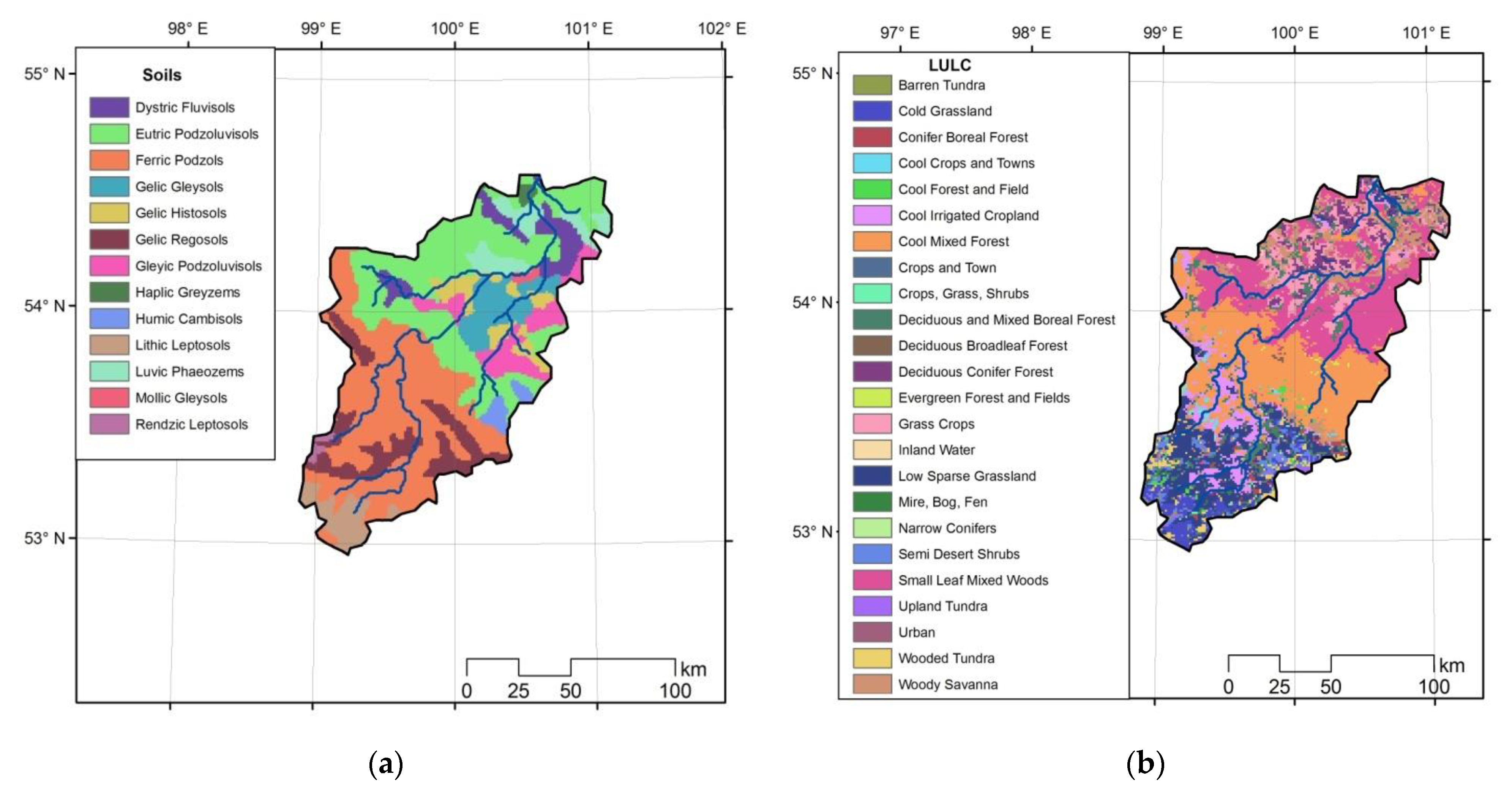

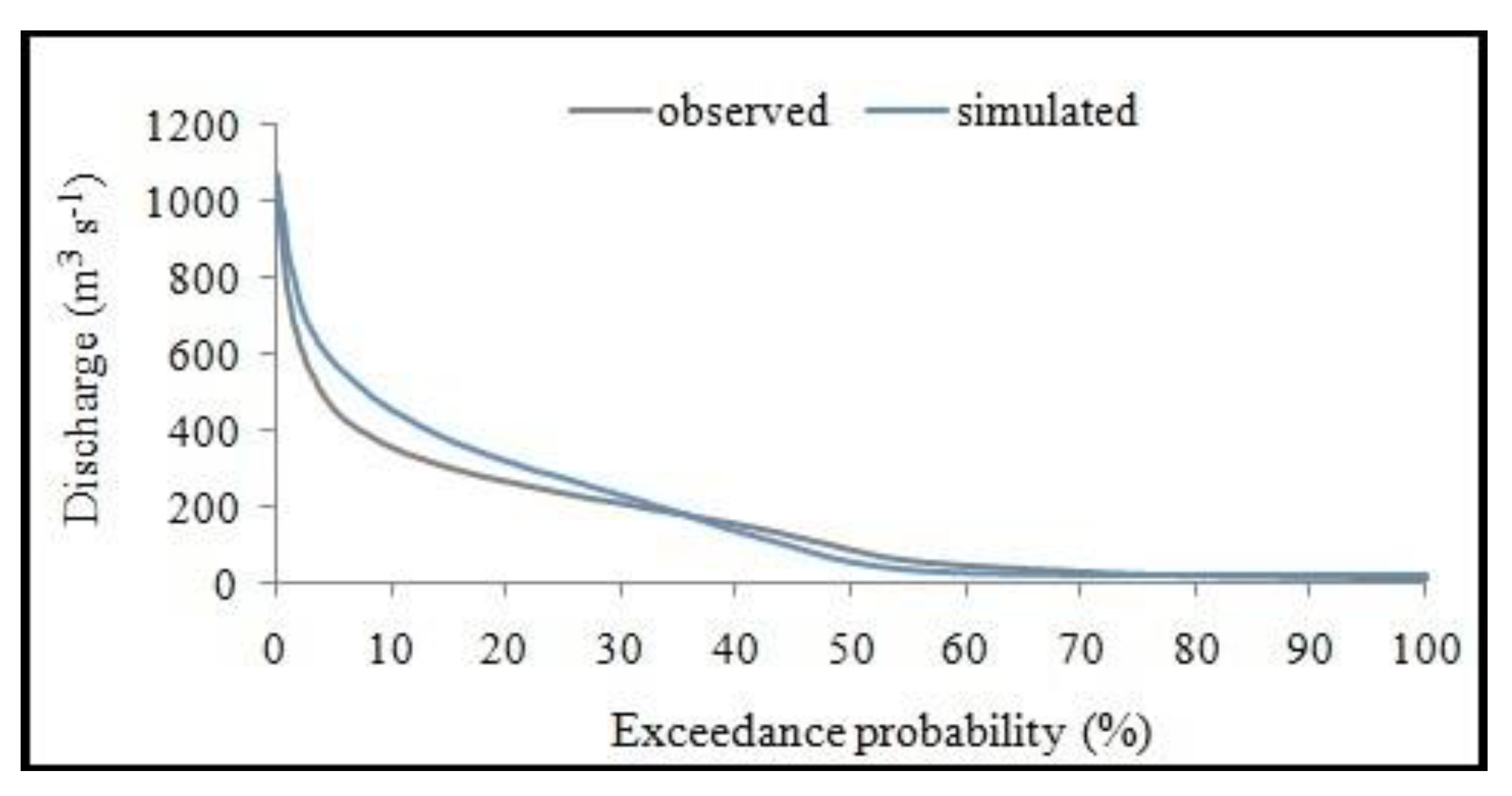
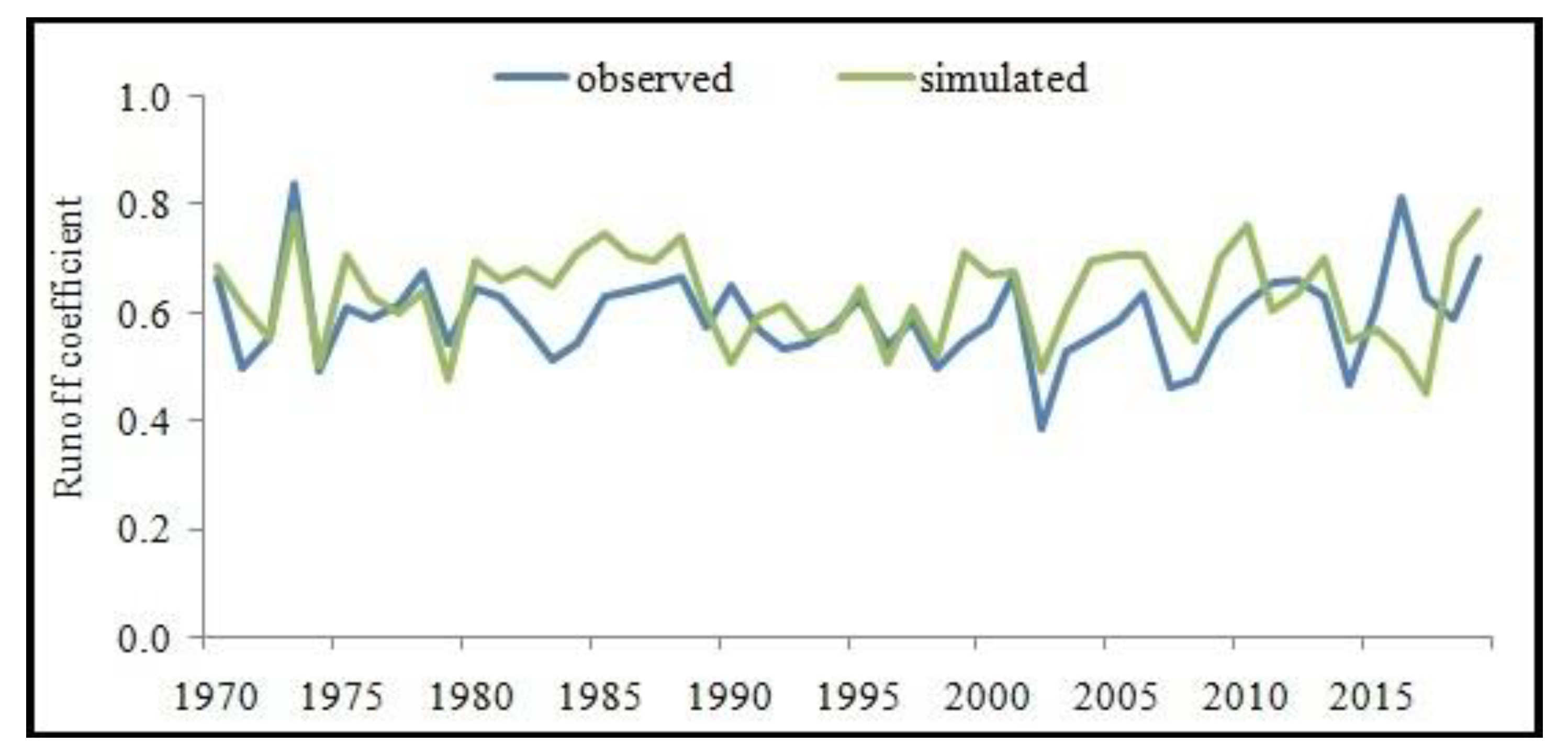
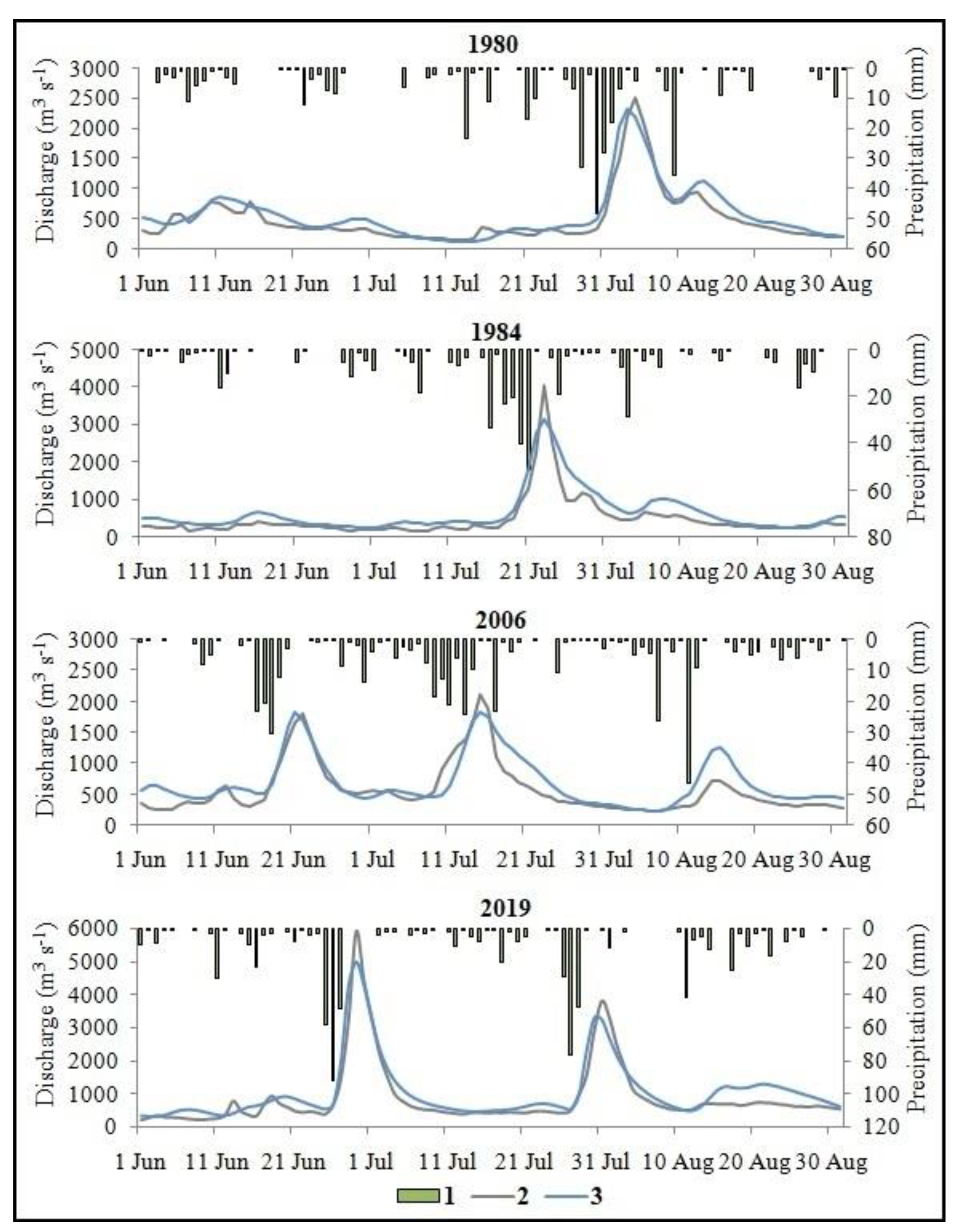
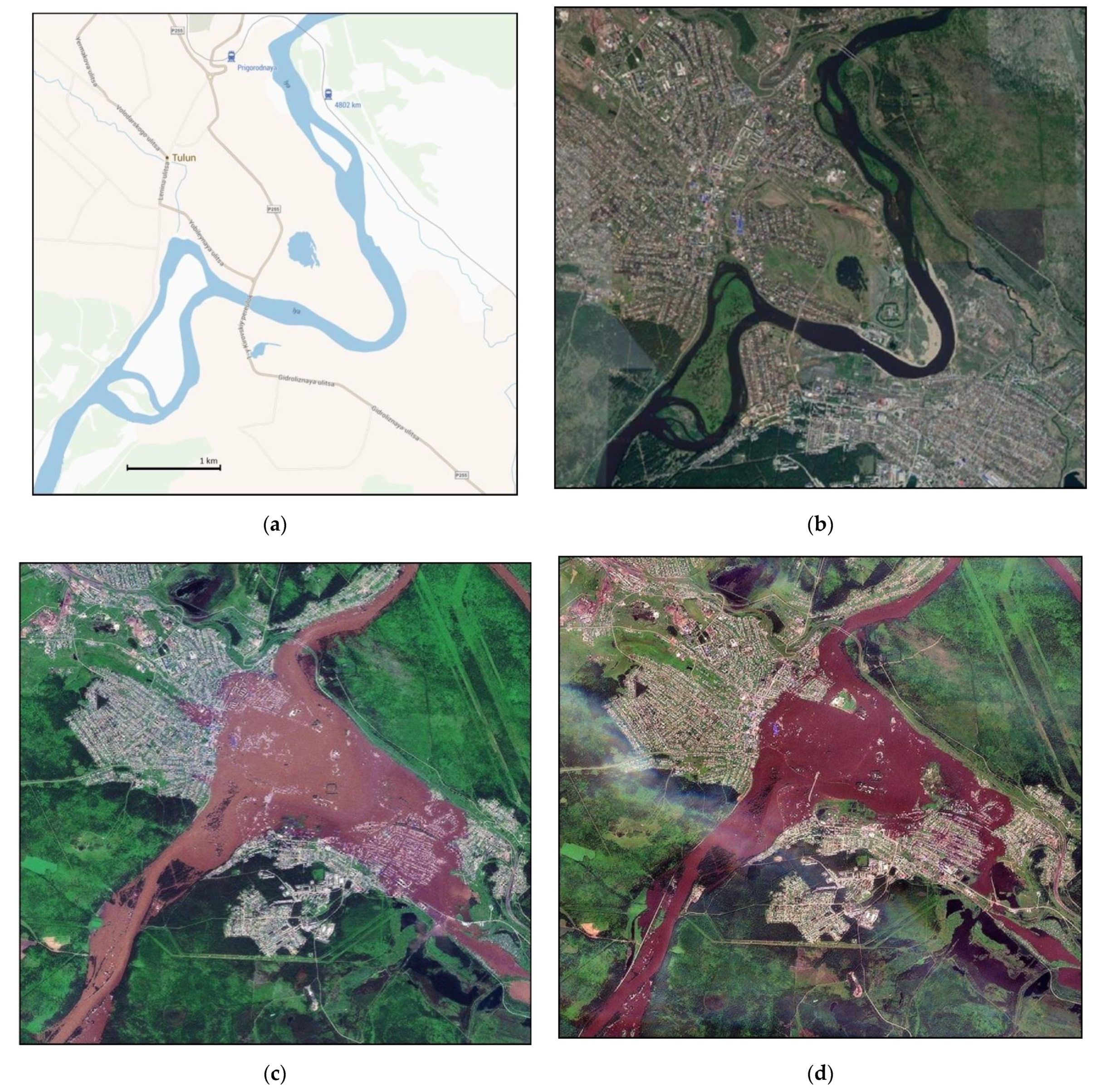
| Index of the World Meteorological Organization | Name | Latitude, ° N | Longitude, ° E | Altitude, m a.s.l. |
|---|---|---|---|---|
| 29894 | Alygdzher | 53.63 | 98.22 | 1031 |
| 30504 | Tulun | 54.6 | 100.6 | 487 |
| 30505 | Kuitun | 54.3 | 101.5 | 520 |
| 30507 | Ikey | 54.18 | 100.08 | 510 |
| 30605 | Saram | 53.3 | 101.2 | 622 |
| Characteristics | The Whole River Basin | Mountainous Area | Lowland Area |
|---|---|---|---|
| Mean annual temperature, °C | −2.5 | −4.6 | −1.3 |
| Summer temperature, °C | 13.2 | 10.4 | 14.7 |
| Annual precipitation, mm | 562 | 690 | 491 |
| Summer precipitation, mm | 321 | 404 | 276 |
| Annual runoff depth, mm | 327 | 542 | 209 |
| Summer runoff depth, mm | 184 | 325 | 107 |
| Calibration | Verification | |||||||
|---|---|---|---|---|---|---|---|---|
| daily discharge | annual peak discharge | hazardous high flow | ||||||
| KGE | PBIAS, % | RSR | R | PBIAS, % | RSR | KGE | PBIAS, % | RSR |
| 0.84 | 8 | 0.51 | 0.97 | −3 | 0.30 | 0.91 | −1 | 0.41 |
| Parameter | Dimension | Value |
|---|---|---|
| Coefficient for horizontal hydraulic conductivity of the topsoil layer | dimensionless | 10 |
| Coefficient for vertical hydraulic conductivity of soil type | dimensionless | 15 |
| Evaporation coefficient of LULC type | dimensionless | 0.35 |
| Baseflow of HRUs | mm day−1 | 0.11 |
| Precipitation gradient | mm 100 m−1 | 4 |
| Air temperature gradient | °C 100 m−1 | −0.6 |
| Air temperature for transformation of precipitation phase | °C | 0.3 |
| Snowmelt air temperature | °C | 0.0 |
| Snowmelt intensity for LULC types | mm °C day−1 | 0.28 |
| Criteria | 1980 | 1984 | 2006 | 2019 | ||||
|---|---|---|---|---|---|---|---|---|
| Q1 | Q2 | Q1 | Q2 | Q1 | Q2 | Q1 | Q2 | |
| KGE | 0.74 | 0.71 | 0.60 | 0.53 | 0.86 | 0.65 | 0.79 | 0.78 |
| PBIAS, % | 13 | 3 | 24 | 10 | 6 | −3 | 10 | 1 |
| RSR | 0.37 | 0.54 | 0.50 | 0.53 | 0.48 | 0.79 | 0.26 | 0.39 |
| Characteristics | 1980 | 1984 | I Wave 2006 | II Wave 2006 | I Wave 2019 | II Wave 2019 |
|---|---|---|---|---|---|---|
| Preflood coefficient of water-saturated soil | 0.87 | 0.93 | 0.94 | 0.91 | 1.00 | 0.95 |
| Runoff coefficient of flood-forming precipitation | 0.67 | 0.83 | 0.73 | 0.75 | 0.88 | 0.81 |
| Period | 1970–1994 | 1995–2019 | ||||
|---|---|---|---|---|---|---|
| Characteristics | T, °C | P, mm | Q, m3 s−1 | ΔT, °C | ΔP, % | ΔQ, % |
| June | 12.0 | 75 | 345 | 1.2 | 26.2 | 3.2 |
| July | 14.2 | 125 | 346 | 1.2 | −2.2 | 0.3 |
| August | 11.6 | 114 | 329 | 1.2 | −1.3 | 8.3 |
| Period | 2021–2050 | 2070–2099 | ||
|---|---|---|---|---|
| Characteristics | RCP 2.6 | RCP 6.0 | RCP 2.6 | RCP 6.0 |
| Peak discharge, % | 3 | 3 | −16 | −23 |
| Hazardous high flow, % | −8 | 15 | −41 | −20 |
| Duration of hazardous high flow, day | 12 | 18 | −3 | 4 |
| Maximum 5-day precipitation, % | 13 | 11 | −5 | 4 |
Publisher’s Note: MDPI stays neutral with regard to jurisdictional claims in published maps and institutional affiliations. |
© 2021 by the author. Licensee MDPI, Basel, Switzerland. This article is an open access article distributed under the terms and conditions of the Creative Commons Attribution (CC BY) license (https://creativecommons.org/licenses/by/4.0/).
Share and Cite
Kalugin, A. Process-Based Modeling of the High Flow of a Semi-Mountain River under Current and Future Climatic Conditions: A Case Study of the Iya River (Eastern Siberia). Water 2021, 13, 1042. https://doi.org/10.3390/w13081042
Kalugin A. Process-Based Modeling of the High Flow of a Semi-Mountain River under Current and Future Climatic Conditions: A Case Study of the Iya River (Eastern Siberia). Water. 2021; 13(8):1042. https://doi.org/10.3390/w13081042
Chicago/Turabian StyleKalugin, Andrey. 2021. "Process-Based Modeling of the High Flow of a Semi-Mountain River under Current and Future Climatic Conditions: A Case Study of the Iya River (Eastern Siberia)" Water 13, no. 8: 1042. https://doi.org/10.3390/w13081042
APA StyleKalugin, A. (2021). Process-Based Modeling of the High Flow of a Semi-Mountain River under Current and Future Climatic Conditions: A Case Study of the Iya River (Eastern Siberia). Water, 13(8), 1042. https://doi.org/10.3390/w13081042






